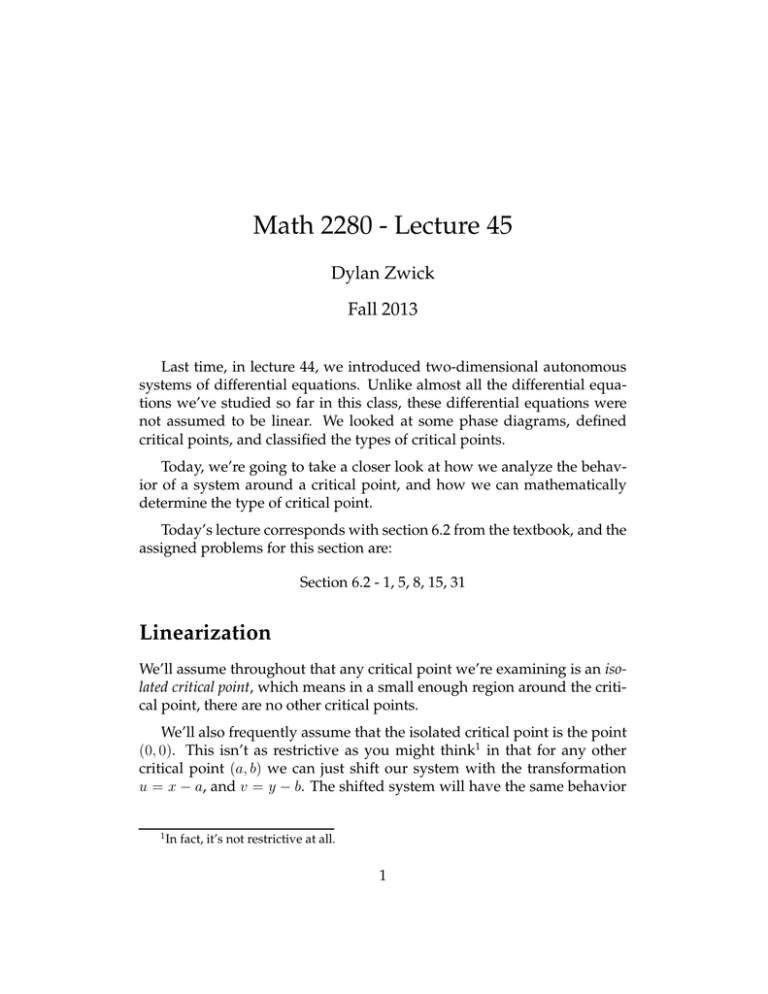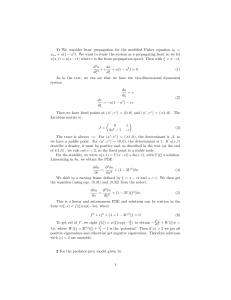Math 2280 - Lecture 45 Dylan Zwick Fall 2013
advertisement

Math 2280 - Lecture 45 Dylan Zwick Fall 2013 Last time, in lecture 44, we introduced two-dimensional autonomous systems of differential equations. Unlike almost all the differential equations we’ve studied so far in this class, these differential equations were not assumed to be linear. We looked at some phase diagrams, defined critical points, and classified the types of critical points. Today, we’re going to take a closer look at how we analyze the behavior of a system around a critical point, and how we can mathematically determine the type of critical point. Today’s lecture corresponds with section 6.2 from the textbook, and the assigned problems for this section are: Section 6.2 - 1, 5, 8, 15, 31 Linearization We’ll assume throughout that any critical point we’re examining is an isolated critical point, which means in a small enough region around the critical point, there are no other critical points. We’ll also frequently assume that the isolated critical point is the point (0, 0). This isn’t as restrictive as you might think1 in that for any other critical point (a, b) we can just shift our system with the transformation u = x − a, and v = y − b. The shifted system will have the same behavior 1 In fact, it’s not restrictive at all. 1 as the original system, just with all x-values shifted to the left by a, and all y-values shifted down by b. If our functions f (x, y) and g(x, y) are continuously differentiable at the critical point (x0 , y0) then around this point we can approximate the functions by: f (x, y) ≈ f (x0 , y0 ) + fx (x0 , y0)x + fy (x0 , y0 )y, g(x, y) ≈ g(x0 , y0 ) + gx (x0 , y0)x + yy (x0 , y0)y. As f (x0 , y0 ) = g(x0 , y0 ) = 0 at a critical point by definition, around a critical point we have: dx = fx (x0 , y0 )x + fy (x0 , y0)y, dt dy = gx (x0 , y0 )x + gy (x0 , y0 )y. dt We can write this in matrix notation as: x′ y′ = fx (x0 , y0) fy (x0 , y0) gx (x0 , y0 ) gy (x0 , y0 ) x y = J(x0 , y0) x y . Here J(x0 , y0 ) is the Jacobian matrix you may remember from multivariable calculus.2 The behavior of our system around a critical point depends on this Jacobian matrix. In particular, it depends upon the eigenvalues of the Jacobian matrix. 2 Or, you may not remember it. 2 Critical Points and Eigenvalues To determine the behavior of our system around a critical point, we look at the eigenvalues of the Jacobian matrix at that critical point. We will assume our critical point is (0, 0), and that the critical point is isolated, which means λ = 0 will not be an eigenvalue of the Jacobian matrix.3 The five possibilities for the two eigenvalues are are: • real and unequal with the same sign; • real and unequal with opposite sign; • real and equal; • complex conjugates with nonzero real part; • pure imaginary numbers. We’ll examine each of these in turn, in the context of an example. 3 Why? 3 Exam pie Suppose (0, 0) is a critical bian matrix at (0, 0) is: - 1(7 point of our system, and the Jaco 3 17 What is the behavior of our solution curves around this critical point? Solution The eigenvalues of this matrix are ) associated eigenvectors - = 13 “ 1 and = 1 and /\ = 2, with 11 = l\3 9 v The correspoding phase diagram looks like: From here we can see that (0. 0) is an improper nodal source. In general, if \I, X are both positive, then we have an improper nodal source, and if they’re both negative, we have an improper nodal sink. 4 Exam pie Suppose (0, 0) is a critical point of our system, and the Jaco bian matrix at (0, 0) is: - 14 5 —3 —5 What is the behavior of our solution curves around this critical point? Solution Here the eiganvalues are eigenvectors: - v j = 1 . i and 1 and —1, with associated (1 v 3 = 2 The correspoding phase diagram looks like: From here we can see that (0, 0) is a saddle point. In general, if is a saddle point. and A 2 are real with opposite sign then the critical point 5 Exaiiiple Suppose (0, 0) is a critical point of our system, and the Jaco bian matrix at (0, 0) is: - 9 11—11 —i 0 What is the behavior of our solution curves around this critical point? Solution Here the eiganvalues are ated eigenvector: - = —1 and ? = —1, with associ /13 The vector 2 V Zr 11 1 shows up in the , but only v 1 is a generalized eigenvector based on v phase diagram: From here we can see that (0, 0) is an improp’r nodal sink. 6 In general, if A 1 and ‘\2 are real and equal, then if there are two linearly independent eigenvectors the critical point is a proper node, and if not the critical point is an improper node. If A , ‘\2 are positive the critical point is 1 a source, while if they’re negative the critical point is a sink. Example Suppose (0, 0) is a critical point of our system, and the Jaco bian matrix at (0. 0) is: - 1 (‘ —10 15 \ ‘ 8 What is the behavior of our solution curves around this critical point? Solution Here the eiganvalues are A phase diagram looks like: - = — ± 3i. The corresponding From here we can see that (0, 0) is a saddle point, and a sink. In general, if A 1 and A 2 are complex conjugates then the critical point is a spiral point. If the real part is negative it’s a sink, and if the real part is positive it’s a source. 7 Exa,iiple Suppose (0, 0) is a critical point of our system, and the Jaco bian matrix at (0, 0) is: - 1( —9 15 \_15 4 k 9 What is the behavior of our solution curves around this critical point? Solution Here the eiganvalues are \ diagram looks like: - = +31. The correspoding phase From here we can see that (0, 0) is a stable center. 8 Stability The eigenvalues of the Jacobian not only tell us the type of critical point, but these eigenvalues also tell us whether or not the critical point is stable. If λ1 , λ2 are the eigenvalues of the Jacobian at a critical point then: 1. The critical point is asymptotically stable if the real parts of both eigenvalues are negative. 2. The critical point is stable but not asymptotically stable if the real parts are both zero. (So the eigenvalues are pure imaginary.) 3. The critical point is unstable if either eigenvalues has a positive real part. We can see examples of all thes possibilities in those examined above. Notes on Homework Problems Exercises 6.2.1, 6.2.5, 6.2.8, 6.2.15, and 6.2.31 are all about finding and clasifying critical points. Shouldn’t be too hard. Don’t worry about verifying your conclusion with a computer system or graphing calculator. 9








